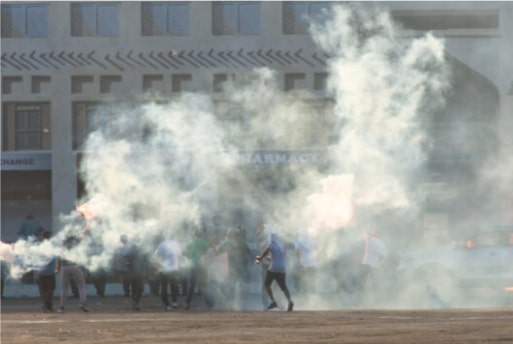What is tear gas?
Tear gas refers to a group of chemical irritants commonly used to control or disperse crowds. The common chemical used for this is 2-chlorobenzalmalonitrile or CS. Contrary to its name, tear gas isn’t a gas. It’s a pressurized powder that creates a mist when released.
What are the effects of tear gas?
The chemicals in tear gas reacts with sensory nerve receptors that can cause pain and discomfort in the skin, eyes, and mucous membranes such as the throat. This leads to tearing of the eyes (hence the name “tear gas”), twitching around the eyes, cough, difficulty breathing, and irritation to the skin.
In high doses, it can cause severe eye and respiratory pain, bleeding, and blindness. It can also lead to the development of respiratory illnesses, severe eye injuries and diseases (such as traumatic optic neuropathy, keratitis, glaucoma, and cataracts), dermatitis, damage of cardiovascular and gastrointestinal systems, and even death. If you are wearing a contact lens, tear gas can be very harmful to your eyes.
People with pre-existing respiratory conditions such as asthma are at particular risk. Also, in people with pre-existing heart conditions, It can cause increased heart rate or blood pressure, which can lead to cardiac arrest or death.
However, the effects of tear gas usually wear off in 15–20 minutes.
How can you protect yourself from tear gas?

Protective equipment such as gas masks and respirators can be used to reduce the effect of tear gas. While swimming goggles can be worn to protect the eyes from the hazardous chemical.
You can minimize your exposure to it by covering your eyes, mouth, nose, and skin as much as possible. Don’t wear contact lenses if you’re going to protest, because if you’re teargassed it can have harmful effects on your eyes.
Wearing a scarf or bandana over your nose and mouth may help prevent some of the gas from entering your airways.
Oil-based creams, sunscreens, and make-up absorb tear gas, so avoid wearing these when going to a protest where it might be used.
Move to a higher elevation as tear gas is heavier than air and so tends to stay close to the ground.
How do you treat tear gas exposure?
There is no specific antidote to tear gases. However, the first line of treatment is getting away from the chemical and into fresh air. Fresh air will help blow off excess tear gas powder and will prevent it from blowing back into your mouth or eyes.
Removing contaminated clothing as quickly as possible and rinsing your clothing and body with cold water can also reduce skin reactions. DO NOT use hot water as it will open your pores and allow the chemicals to seep further in, resulting in even more skin irritation.
Saline solution or water can be used to rinse the eyes of those affected.
Don’t rub your eyes or face, or this will reactivate any tear gas crystal.
Shower when you get home, using cold water to avoid further irritation. Do your best not to breathe in more tear gas during the shower, and keep your eyes closed. Wash your hair, especially well. DO NOT take a bath – as you will only soak yourself in the chemicals.

In all of these, stay safe as you go out there to exercise your right to a peaceful protest. You can also learn how to protect yourself during a protest.





This is so educative and eye opening… Thanks for sharing doctor.